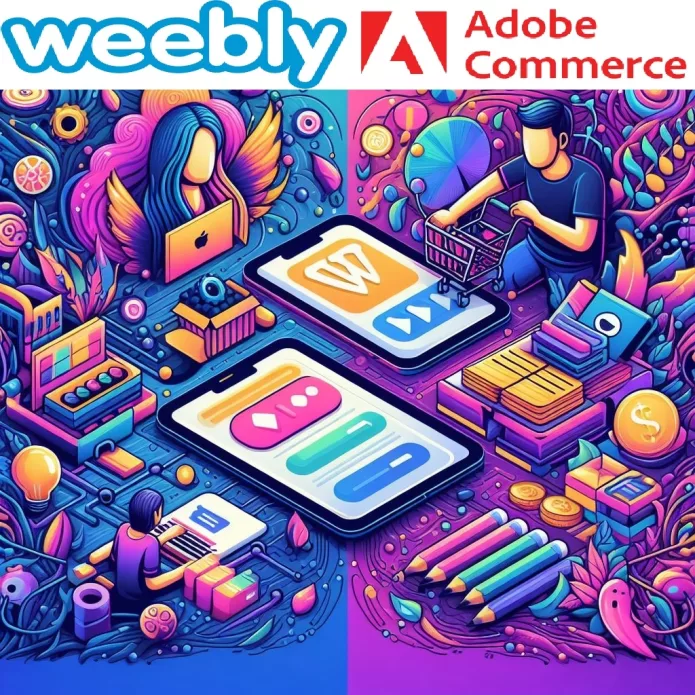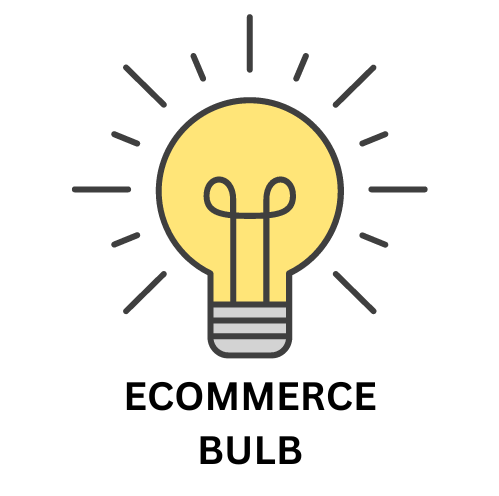
In order to decide which ecommerce platform to use, Weebly vs Adobe Commerce. A detailed comparison between features must be thoroughly done. If you want to decide which eCommerce platform to choose, there are many things to consider.
These are some examples of these factors:
- Cost.
- SEO friendliness.
- Page load speed.
- Canonical website URL.
- Indexing Control.
- Customizable HTML capabilities.
- Sitemap Generator.
- Integration with Google Analytics.
- Product Tagging and Categorization.
- Batch Uploading.
- Mobile Optimization.
- Built-in Blogging and Marketing Features.
- Social Sharing Buttons.
- Content Management Capabilities.
- Discount and promotion code tools.
- Easy to use Checkout.
- Reporting tools and custom reports.
- Integration of email marketing tools.
- Multiple payment options.
- Flexibility to add new eCommerce features.
- Exclusive features.
- Cons and pros.
Here we’ll discuss these factors to help you decide which platform is better for you, Adobe Commerce or Weebly. And at the end of the discussion, we’ll recap and make a comparison for the scores of all these points to find out which eCommerce platform has the higher score, so that you’ll have a good view about both of them.

Pricing (Weebly vs Adobe Commerce):

When comparing pricing between Weebly and Adobe Commerce (formerly Magento), you’re comparing two platforms in distinctly different price tiers:
Weebly:
- Pricing structure: Weebly offers tiered pricing plans with clear monthly fees.
- Free plan: Offers basic website building features and limited product listings.
- Personal plan: Starts at $6 per month, ideal for personal websites or small businesses.
- Professional plan: Starts at $12 per month, suitable for growing businesses with eCommerce needs.
- Business plan: Starts at $25 per month, offers advanced features like abandoned cart recovery and integrations.
- Transaction fees: Depending on your plan, Weebly charges 3% or 2% transaction fees on online sales.
- Hidden costs: Consider potential additional fees for domain name renewal and third-party app integrations.
Adobe Commerce:
- Pricing structure: Adobe Commerce does not have publicly available price information. Instead, they offer custom quotes based on your specific needs and website complexity. This can range from thousands to tens of thousands of dollars per year.
- Additional costs: On top of the base platform cost, you need to factor in hosting fees, theme and extension purchases, potential developer fees for customization, and maintenance costs.
- Scalability: Adobe Commerce scales efficiently for large, complex websites with high traffic volume, but this comes at a significantly higher cost compared to Weebly.
Here’s a table summarizing the key differences:
| Feature | Weebly | Adobe Commerce |
|---|---|---|
| Pricing structure | Transparent tiered plans | Custom quotes based on needs |
| Base cost | Starts at $6 per month | Thousands to tens of thousands per year |
| Transaction fees | 3% or 2% on certain plans | None |
| Hidden costs | Potential domain and app fees | Hosting, themes, extensions, development, maintenance |
| Scalability | Suitable for small and medium businesses | Highly scalable for large, complex websites |
Choosing the right platform:
- For most businesses: Weebly’s clear pricing structure and affordable plans make it a great choice for startups, small businesses, and even personal websites.
- For large, complex businesses: Adobe Commerce offers advanced features, scalability, and customizability, but its high cost and complexity make it suitable only for large businesses with significant online sales and technical expertise.
- Consider your needs: Analyze your website size, feature requirements, budget, and technical skills to determine which platform aligns with your capabilities and needs.

SEO Capabilities (Weebly vs Adobe Commerce):

Comparing SEO capabilities between Weebly and Adobe Commerce (formerly Magento) requires considering different strengths and weaknesses:
Weebly:
- Pros:
- User-friendly interface: Weebly simplifies basic SEO tasks like sitemap generation, meta tag editing, and image optimization, making it easy for beginners to improve their website’s search engine visibility.
- Built-in SEO tools: Weebly comes with features like mobile-friendliness, clean code structure, and automatic redirects, providing a solid foundation for good SEO practices.
- Free plan available: Even the free plan includes basic SEO tools, allowing you to optimize your website from the initial stages.
- Cons:
- Limited control: Weebly offers less control over advanced SEO elements like page speed optimization, canonicalization, and structured data markup, which can limit your ability to fully optimize your site.
- Fewer integrations: Weebly’s App Center, while offering some SEO-related tools, is smaller than Adobe Commerce’s, limiting your options for advanced SEO customization.
- Less flexibility: Weebly’s template-based structure provides less flexibility for structuring your website’s content in a way that prioritizes SEO best practices.
Adobe Commerce:
- Pros:
- Advanced SEO features: Adobe Commerce offers extensive SEO functionality, including full control over page speed optimization, canonicalization, rich snippets, structured data markup, and robots.txt editing.
- Extensive integrations: Adobe Commerce integrates with numerous SEO tools and extensions, allowing you to customize your SEO strategy for deeper optimization.
- Flexibility: Adobe Commerce’s open-source nature and customizability empower you to structure your website content and user experience in a way that prioritizes SEO best practices.
- Cons:
- Complexity: Adobe Commerce’s advanced features require technical expertise to utilize effectively, making it less suitable for beginners with limited SEO knowledge.
- Cost: The higher cost of Adobe Commerce, in addition to potential fees for SEO extensions and developer support, can be a barrier for smaller businesses.
- Steeper learning curve: Using Adobe Commerce’s advanced SEO features effectively requires more time and effort to learn and implement compared to Weebly’s simpler tools.
Choosing the right platform:
- For beginners: Weebly’s user-friendly interface and built-in SEO tools make it a good starting point for basic SEO optimization.
- For advanced SEO: Adobe Commerce’s extensive features and customization options provide greater control and flexibility for experienced users to implement complex SEO strategies.
- For budget considerations: Weebly’s lower cost makes it more accessible for businesses with limited budgets, while Adobe Commerce’s higher cost necessitates careful evaluation of its ROI for SEO improvements.
- For technical expertise: Weebly’s ease of use caters to users with minimal technical knowledge, while Adobe Commerce’s advanced features require understanding of SEO best practices and technical implementation.

PageLoad Speed (Weebly vs Adobe Commerce):

Page load speed is crucial for user experience and website performance, influencing both SEO and conversion rates. When comparing Weebly and Adobe Commerce (formerly Magento), both have their strengths and weaknesses in this area:
Weebly:
- Pros:
- Simple architecture: Weebly’s platform architecture is generally lightweight and optimized for speed, resulting in faster page load times compared to complex platforms like Adobe Commerce.
- Built-in CDN: Weebly includes a Content Delivery Network (CDN) by default, which distributes website content across geographically distributed servers, ensuring faster loading times for users in different locations.
- Easy image optimization: Weebly provides basic image compression tools within the platform, helping reduce image file sizes without significant quality loss, improving page load speeds.
- Cons:
- Limited control: Weebly offers less control over server-side optimization and advanced caching mechanisms, making it harder to fine-tune page load speeds for complex websites.
- Theme limitations: Some Weebly themes, while aesthetically pleasing, can be heavier and contribute to slower loading times, especially if not optimized.
- Third-party integrations: Adding numerous third-party apps or plugins can potentially slow down your Weebly website, requiring careful selection and monitoring.
Adobe Commerce:
- Pros:
- Advanced caching: Adobe Commerce offers powerful caching mechanisms and server-side optimization techniques, allowing for fine-tuning page load times for even the most complex websites.
- Customizability: You have complete control over the server environment and codebase in Adobe Commerce, enabling optimization through custom plugins and configurations.
- Performance optimization modules: The Adobe Commerce ecosystem offers numerous performance optimization modules and extensions to address specific bottlenecks and improve page load speeds.
- Cons:
- Complex architecture: Adobe Commerce’s complex platform architecture and layered functionalities can inherently lead to slower page load times compared to simpler platforms like Weebly.
- Technical expertise required: Optimizing page load speeds in Adobe Commerce effectively requires significant technical knowledge and expertise in server configuration and performance optimization techniques.
- Cost: Implementing advanced optimization solutions in Adobe Commerce can involve additional costs for performance optimization modules and developer expertise.
Choosing the right platform:
- For simple websites: Weebly’s inherent speed and built-in optimization features are sufficient for most basic websites with limited traffic.
- For complex websites: Adobe Commerce offers superior control and optimization potential for large, complex websites with high traffic, justifying the technical challenges and potential cost considerations.
- For technical skills: Weebly’s user-friendly interface is suitable for beginners, while Adobe Commerce’s optimization requires technical expertise.
- For budget: Weebly’s lower cost makes it a more budget-friendly option, while optimizing Adobe Commerce might involve additional expenses.

Canonical Website URL (Weebly vs Adobe Commerce):

Weebly:
- Automatic canonicalization: Weebly automatically adds canonical tags to your website pages, indicating to search engines the preferred, original version of a page. This helps prevent duplicate content issues and ensures search engines index the correct URLs.
- Limited control: You have minimal control over canonical tags in Weebly. The platform handles them automatically, which is usually sufficient for most small to medium-sized websites.
- Potential issues with custom URLs: If you use custom URLs or redirects in Weebly, you might need to manually adjust canonical tags to ensure they are accurate.
Adobe Commerce:
- Full control over canonical tags: Adobe Commerce gives you complete control over canonical tags through code editing or extensions. This allows you to fine-tune canonicalization for specific pages or sections of your website, as needed for complex sites with multiple content variations.
- Technical expertise required: Understanding and implementing canonical tags in Adobe Commerce requires technical knowledge of code editing or familiarity with relevant extensions.
- Flexibility for advanced scenarios: Adobe Commerce’s flexibility allows you to address complex canonicalization scenarios, such as handling multiple language versions or product variations, which might be less straightforward in Weebly.
Choosing the right platform:
- For most small to medium-sized websites: Weebly’s automatic canonicalization is often sufficient and easier to manage without technical expertise.
- For large, complex websites: Adobe Commerce’s flexibility and control over canonicalization are beneficial for managing potential duplicate content issues in large-scale or advanced website structures.
- Technical expertise: If you have the technical knowledge or access to developer resources, Adobe Commerce’s control over canonical tags can be advantageous.

Indexing Control (Weebly vs Adobe Commerce):

Weebly:
- Basic indexing controls:
- Robots.txt editor: Allows you to specify which pages search engines should crawl and index.
- Noindex meta tag: Can be manually added to individual pages to prevent them from being indexed.
- Limited granular control: Weebly doesn’t offer advanced options for indexing control, such as sitemap priority adjustments or selective indexing of specific content types.
Adobe Commerce:
- Extensive indexing controls:
- Full robots.txt and meta tag control: Fine-tune indexing instructions for individual pages, directories, or content types.
- Sitemap customization: Create and submit multiple sitemaps, prioritize pages, and control crawling frequency.
- Extensions for advanced control: Access additional indexing options through extensions, such as managing indexation of product variations or layered navigation pages.

Customizable HTML Capabilities (Weebly vs Adobe Commerce):

Weebly:
- Limited HTML editing:
- Provides basic HTML editing options within certain elements like text blocks, but not full control over the entire website structure.
- Useful for making minor adjustments to content formatting or styling.
- Not ideal for extensive customization or building unique website layouts.
- Code blocks: Allows you to insert custom HTML code blocks into specific sections, but this can disrupt the visual editor’s functionality and might require technical knowledge to manage.
- Apps for enhanced customization: The Weebly App Center offers some apps that extend customization options, but they often have their own limitations and might not offer complete control over HTML elements.
Adobe Commerce:
- Full HTML and CSS access:
- Provides complete access to the underlying HTML and CSS of your website, enabling you to create unique designs, integrate custom elements, and tailor the user experience precisely.
- Full control over website structure and functionality.
- Ideal for developers and designers with technical expertise.
- Theme customization: Most Adobe Commerce themes are built with customizable HTML and CSS, allowing you to modify them extensively to match your brand and preferences.
- Extensions for further customization: The Adobe Commerce marketplace offers a vast array of extensions that add custom features and functionalities, often involving HTML and CSS modifications.
Choosing the right platform:
- For users without coding experience: Weebly’s simpler approach is more user-friendly, but it might feel restrictive for those seeking extensive customization.
- For developers and designers: Adobe Commerce’s full HTML and CSS control provide the freedom to create unique and tailored websites, but it requires technical knowledge and experience.
- Desired level of customization: If you have specific design requirements or want to integrate custom elements, Adobe Commerce offers the flexibility to achieve those goals.

Sitemap Generators (Weebly vs Adobe Commerce):

Weebly:
- Automatic sitemap generation: Weebly automatically creates an XML sitemap for your website, listing all your pages and product URLs.
- Limited customization: You have minimal control over the generated sitemap, such as:
- Adjusting sitemap frequency (how often it’s updated).
- Excluding certain pages.
- Customizing priorities for different pages.
- No visual sitemap: Weebly doesn’t offer a visual sitemap for users to view and navigate the website structure.
Adobe Commerce:
- Flexible sitemap generation:
- Built-in sitemap generator with more customization options.
- Ability to create multiple sitemaps for different sections of your website.
- Control over page priorities, crawling frequency, and content inclusion.
- Extensions for advanced features:
- Access to third-party extensions for more sophisticated sitemap generation, including:
- Visual sitemap generators.
- Sitemaps for images and videos.
- Sitemaps for specific content types.
- Access to third-party extensions for more sophisticated sitemap generation, including:
Choosing the right platform:
- For simple websites: Weebly’s automatic sitemap generation is often sufficient, especially for smaller websites with a straightforward structure.
- For complex websites: Adobe Commerce’s flexible sitemap generation and extensions allow you to tailor sitemaps for large product catalogs, dynamic content, or specific SEO needs.
- Technical expertise: Advanced sitemap customization in Adobe Commerce might require technical knowledge or developer resources.

Integration With Google Analytics (Weebly vs Adobe Commerce):

Both Weebly and Adobe Commerce offer integration with Google Analytics, but with varying levels of ease and functionality:
Weebly:
- Simple integration: Weebly provides a built-in option to connect your website to Google Analytics with just a few clicks. No coding or manual configuration required.
- Basic tracking: Weebly automatically tracks basic website activity like page views, traffic sources, and visitor demographics.
- Limited customization: Weebly offers limited control over custom events, user tracking, or advanced analytics features.
- Suitable for beginners: Perfect for those starting with Google Analytics and wanting a simple setup without technical expertise.
Adobe Commerce:
- Advanced integration: Requires adding the Google Analytics code manually or through an extension, offering more control over tracking setup.
- Extensive tracking: Provides in-depth data on user behavior, eCommerce performance, marketing campaigns, and custom events.
- Deep customization: Allows you to configure custom dimensions, goals, user tracking, and integrate with advanced Google Analytics features.
- Requires technical knowledge: Setting up a complex Google Analytics integration might require developer assistance for non-technical users.
Choosing the right platform:
- For website basics: Weebly’s built-in integration is ideal for tracking basic website traffic and basic visitor behavior.
- For eCommerce and advanced analytics: Adobe Commerce’s advanced integration and customizability cater to businesses needing detailed insights into user behavior, marketing performance, and complex goals.
- Technical expertise: Consider your comfort level with code and analytics configuration. Weebly is easier for beginners, while Adobe Commerce requires more technical knowledge.

Product Tagging and Categorization (Weebly vs Adobe Commerce):

Weebly:
- Basic tagging:
- Assign simple tags to products for organization and filtering.
- Limited control over tag hierarchy or relationships.
- Simple categorization:
- Create product categories with basic nesting (subcategories).
- Lacks advanced features like category attributes or conditional visibility.
- User-friendly interface:
- Straightforward process for assigning tags and categories, suitable for beginners.
- Limited customization:
- Options for customizing tag and category display on the storefront are restricted.
Adobe Commerce:
- Advanced tagging:
- Create tags with custom attributes and relationships.
- Use tags for product segmentation, targeted marketing, and dynamic product recommendations.
- Flexible categorization:
- Build complex category structures with unlimited nesting levels.
- Assign multiple categories to a single product.
- Define category-specific attributes and rules for conditional visibility.
- Customizable display:
- Control how tags and categories are displayed on the storefront through themes and extensions.
- Technical expertise needed:
- Utilizing advanced tagging and categorization features effectively often requires technical knowledge or developer assistance.
Choosing the right platform:
- For small product catalogs: Weebly’s basic tagging and categorization might be sufficient.
- For large, complex catalogs: Adobe Commerce’s advanced features are essential for efficient organization and navigation.
- Product segmentation and personalization: Adobe Commerce’s advanced tagging enables more sophisticated marketing strategies and personalized product recommendations.
- Technical expertise: If you lack technical knowledge, Weebly’s simpler approach is easier to manage, while Adobe Commerce’s flexibility requires technical skills.

Batch Uploading (Weebly vs Adobe Commerce):

Weebly:
- Limited batch uploading:
- No built-in feature for batch uploading multiple products simultaneously.
- Requires manual addition of products, which can be time-consuming for large catalogs.
- Third-party apps:
- Some third-party apps in the Weebly App Center offer limited batch uploading capabilities, but they might have restrictions or additional costs.
Adobe Commerce:
- Native batch uploading:
- Built-in functionality to import multiple products in bulk using CSV files or direct database imports.
- Supports various data formats and attribute mapping for efficient product catalog management.
- Flexible configuration:
- Control how product data is imported, including image handling, inventory management, and attribute mapping.
- Advanced features:
- Extensions can enhance batch uploading with features like scheduled imports, product updates, and data validation.
Choosing the right platform:
- Large product catalogs: Adobe Commerce’s native batch uploading is essential for efficiently managing large numbers of products.
- Frequent updates: If you regularly add or update products, Adobe Commerce’s batch uploading capabilities save significant time and effort.
- Technical expertise: While Adobe Commerce’s batch uploading is powerful, it requires some technical knowledge to configure and use effectively.

Mobile Optimization (Weebly vs Adobe Commerce):

When it comes to mobile optimization, both Weebly and Adobe Commerce offer strong features, but with distinct strengths and considerations:
Weebly:
- Strengths:
- Mobile-first design: Weebly boasts a mobile-first design philosophy, meaning your website automatically adapts to mobile devices for optimal viewing and navigation.
- Drag-and-drop editor: The user-friendly drag-and-drop editor allows you to easily customize your website’s mobile layout without needing coding knowledge.
- Built-in responsive themes: Most Weebly themes are inherently responsive, ensuring your website adapts seamlessly to different screen sizes and devices.
- Easy app integration: Integrating mobile apps and functionalities through the Weebly App Center is straightforward, enhancing your mobile website’s capabilities.
- Weaknesses:
- Limited control: While mobile-friendly, Weebly offers less fine-grained control over responsive design compared to Adobe Commerce.
- Theme dependence: Certain Weebly themes might not be inherently mobile-optimized, requiring careful theme selection or customization.
- Performance limitations: For complex websites with heavy content, mobile performance might be slower compared to optimized Adobe Commerce sites.
Adobe Commerce:
- Strengths:
- Advanced customization: Adobe Commerce allows for detailed control over every aspect of your website’s mobile layout and functionality through code editing and extensions.
- Performance optimization: You can fine-tune mobile speed and performance through server-side optimization and caching mechanisms, crucial for heavy or complex websites.
- Dedicated mobile editor: Adobe Commerce provides a specific mobile editor for fine-tuning your website’s appearance and functionalities specifically for mobile devices.
- Extensive extension library: The vast Adobe Commerce extension library offers numerous options for optimizing and enhancing your mobile website experience.
- Weaknesses:
- Technical expertise required: Utilizing Adobe Commerce’s advanced mobile optimization features effectively requires technical knowledge or developer assistance.
- Potentially higher cost: Customizing and optimizing your mobile website in Adobe Commerce might involve additional costs for developer resources or specific extensions.
- Steeper learning curve: The complexity of Adobe Commerce’s mobile optimization tools can be more challenging to learn and implement compared to Weebly’s user-friendly mobile-first approach.
Choosing the right platform:
- For simple mobile websites: Weebly’s mobile-first design and user-friendly interface make it ideal for basic websites with straightforward mobile experiences.
- For complex mobile needs: Adobe Commerce’s advanced customization, performance optimization, and extensive extension library cater to businesses with complex mobile requirements and heavy traffic.
- Technical expertise: If you lack technical knowledge, Weebly’s ease of use for mobile optimization is beneficial, while Adobe Commerce requires technical expertise for its full potential.
- Budget considerations: Weebly’s simpler approach is more budget-friendly, while optimizing your mobile website in Adobe Commerce might involve additional costs.

Built-in Blogging & Marketing Features (Weebly vs Adobe Commerce):

When comparing built-in blogging and marketing features, both Weebly and Adobe Commerce offer helpful tools, but cater to different needs and require varying levels of technical expertise:
Weebly:
- Strengths:
- Easy-to-use blogging platform: Weebly’s blog editor is user-friendly, making it easy to create and publish blog posts with basic formatting and images.
- Built-in SEO tools: Weebly provides essential SEO tools like meta tag editing and sitemap generation, helpful for basic search engine optimization.
- Email marketing tools: Weebly offers basic email marketing capabilities, allowing you to create and send email campaigns directly from the platform.
- Social media integration: Weebly integrates with various social media platforms for easy sharing and promoting your blog content.
- Weaknesses:
- Limited blogging features: Weebly’s blogging platform lacks advanced features like post scheduling, custom RSS feeds, and advanced analytics.
- Basic marketing capabilities: Weebly’s built-in marketing tools are suitable for basic needs but might not suffice for complex marketing strategies.
- Limited customization: Weebly offers less control over blog and marketing features compared to Adobe Commerce.
Adobe Commerce:
- Strengths:
- Advanced blogging platform: Adobe Commerce provides a powerful blogging platform with features like post scheduling, custom RSS feeds, and detailed analytics.
- Comprehensive marketing tools: Adobe Commerce offers a robust set of marketing tools for email marketing, customer segmentation, campaign management, and personalization.
- High degree of customization: You have significant control over every aspect of your blog and marketing features through code editing and extensions.
- Integration with CRM systems: Adobe Commerce seamlessly integrates with various CRM systems for enhanced customer relationship management.
- Weaknesses:
- Steeper learning curve: Adobe Commerce’s blogging and marketing features can be complex to learn and utilize effectively, requiring technical knowledge or developer assistance.
- Potentially higher cost: Utilizing advanced blogging and marketing features in Adobe Commerce might involve additional costs for extensions or developer resources.
- Technical expertise required: Implementing and customizing blogging and marketing features in Adobe Commerce requires understanding code or familiarity with relevant extensions.
Choosing the right platform:
- For basic blogging and marketing needs: Weebly’s user-friendly approach and built-in tools are suitable for beginners or businesses with straightforward blogging and marketing requirements.
- For complex content strategies and advanced marketing: Adobe Commerce’s comprehensive features and customization options cater to businesses with complex content strategies, targeted marketing campaigns, and high website traffic.
- Technical expertise: If you lack technical knowledge, Weebly’s ease of use is advantageous, while Adobe Commerce’s powerful features require technical expertise for effective utilization.
- Budget considerations: Weebly’s simpler approach is more budget-friendly, while Adobe Commerce’s advanced features might involve additional costs.

Social Sharing Buttons Availability (Weebly vs Adobe Commerce):

Both Weebly and Adobe Commerce offer built-in social sharing buttons, but the specific options and capabilities differ:
Weebly:
- Strengths:
- Easy integration: Most Weebly themes include built-in social sharing buttons for popular platforms like Facebook, Twitter, LinkedIn, and Pinterest.
- Simple configuration: You can easily customize the button placement and style directly within the Weebly editor with just a few clicks.
- No coding required: No need for technical knowledge to implement and use the social sharing buttons.
- Weaknesses:
- Limited options: Weebly offers a standard set of social sharing buttons and lacks the ability to add additional platforms or customize button functionality beyond basic styling.
- Theme dependence: The availability and style of social sharing buttons might vary depending on the chosen Weebly theme.
- Basic tracking: Weebly provides basic tracking of social shares, but advanced analytics with insights into social engagement are not readily available.
Adobe Commerce:
- Strengths:
- Extensive options: You can integrate buttons for a wider range of social platforms through built-in features and extensions.
- Advanced customization: Adobe Commerce allows you to customize the button appearance, functionality (e.g., share counts, pop-ups), and targeting based on specific website sections or pages.
- Detailed analytics: Adobe Commerce integrates with social media analytics tools to provide comprehensive insights into social engagement and campaign performance.
- Weaknesses:
- Technical knowledge required: Implementing and customizing advanced social sharing features in Adobe Commerce might require developer assistance or understanding of code editing.
- Potential cost considerations: Some extensions for advanced social sharing functionalities might involve additional costs.
- Steeper learning curve: Utilizing the full potential of Adobe Commerce’s social sharing features can be more complex compared to Weebly’s simple integration.
Choosing the right platform:
- For basic social sharing needs: Weebly’s built-in buttons are sufficient for sharing content on popular platforms without needing technical expertise.
- For advanced social engagement and tracking: Adobe Commerce’s extensive options, customization capabilities, and detailed analytics cater to businesses seeking deeper insights into social media performance and implementing targeted social sharing strategies.
- Technical expertise: If you lack technical knowledge, Weebly’s simple social sharing buttons are easier to manage, while Adobe Commerce’s advanced features require technical skills.
- Budget considerations: Weebly’s built-in social sharing is included in your plan, while some advanced features in Adobe Commerce might involve additional costs for extensions.

Content Management Capabilities (Weebly vs Adobe Commerce):

Choosing the right platform for content management (CM) hinges on your specific needs and priorities. Here’s a breakdown of how Weebly and Adobe Commerce stack up:
Ease of Use:
- Weebly: Wins for user-friendly drag-and-drop editor, even for those with no coding experience. Ideal for beginners and smaller projects.
- Adobe Commerce: Steeper learning curve with code customization and technical requirements. Suitable for experienced users or with developer resources.
Content Features:
- Weebly: Offers basic content types like text, images, galleries, and blog posts. Limited in advanced layouts and custom content types.
- Adobe Commerce: Extensive range of content types, including forms, product pages, landing pages, and rich media. Highly customizable layouts and flexibility for custom content types.
Scalability:
- Weebly: Handles smaller websites efficiently, but might feel restrictive for large content volumes or complex functionalities.
- Adobe Commerce: Highly scalable and robust, catering to large sites with high traffic and complex content needs.
Security:
- Weebly: Provides built-in security features and regular updates.
- Adobe Commerce: Requires more active security management due to open-source nature. May need additional security plugins or developer expertise.
SEO Capabilities:
- Weebly: Offers basic SEO tools like meta tags and sitemaps. Limited control over advanced SEO configuration.
- Adobe Commerce: Extensive SEO features with fine-grained control over indexing, canonicalization, and technical optimization. Requires technical knowledge for effective implementation.
Integrations:
- Weebly: Integrates with popular apps and services through its App Center, but options might be limited for specific needs.
- Adobe Commerce: Vast extension marketplace with extensive integrations for diverse functionalities and marketing tools.
Budget:
- Weebly: Affordable pricing plans, suitable for individual users or small businesses.
- Adobe Commerce: Higher cost due to licensing fees and potential additional expenditures for extensions and developer support.
Choosing the right platform:
- For simple websites and beginners: Weebly’s user-friendly interface and basic features offer a straightforward solution.
- For complex content needs, high traffic, and advanced SEO: Adobe Commerce’s flexibility, scalability, and advanced features cater to demanding requirements, but necessitate technical expertise and potentially higher costs.

Discounts & Promotion Codes (Weebly vs Adobe Commerce):

Both Weebly and Adobe Commerce offer features for managing discounts and promotional codes, but they cater to different levels of complexity and needs:
Weebly:
Strengths:
- Easy to use: Simple interface for creating and managing basic discounts and promotional codes.
- Built-in options: Pre-built coupon types for percentage discounts, fixed amount discounts, and free shipping.
- Basic scheduling: Schedule promo codes to activate and expire on specific dates.
- Limited customization: Some customization options for coupon appearance and targeting by product categories.
Weaknesses:
- Limited features: Lacks advanced functionality like tiered discounts, user segmentation, or dynamic product discounts.
- Basic tracking: Provides basic insights into coupon usage but lacks detailed analytics on performance and customer behavior.
- Integration limitations: Limited built-in integrations with marketing tools or CRM systems for advanced coupon campaigns.
Adobe Commerce:
Strengths:
- Extensive features: Create complex discount structures with tiered discounts, product bundles, minimum order thresholds, and targeted promotions.
- Advanced customization: Fine-tune coupon appearance, behavior, and targeting based on user segments, purchase history, and other criteria.
- Detailed analytics: Track coupon usage, conversion rates, and customer behavior in detail to optimize your campaigns.
- Integrations: Integrates with various marketing tools and CRM systems for sophisticated coupon strategies and customer segmentation.
Weaknesses:
- Steeper learning curve: Requires technical knowledge or developer assistance to utilize advanced features effectively.
- Potentially higher cost: Advanced features might involve additional expenses for extensions or developer support.
- More complex setup: Creating and managing intricate discount structures can be time-consuming compared to Weebly’s simplicity.
Choosing the right platform:
- For simple discount needs: Weebly’s user-friendly interface and built-in options are sufficient for creating and managing basic promotions.
- For complex promotional strategies and detailed analytics: Adobe Commerce’s extensive features, customization options, and integrations cater to businesses requiring sophisticated discount structures and deep insights into campaign performance.

Easy to Use Checkout (Weebly vs Adobe Commerce):

When it comes to ease of use for your checkout process, both Weebly and Adobe Commerce offer different strengths and considerations:
Weebly:
Strengths:
- Simple and intuitive checkout: Weebly’s checkout process is designed to be straightforward and user-friendly for both you and your customers.
- Minimal setup: Requires minimal configuration and customization, making it easy to get started quickly.
- Mobile-friendly checkout: Mobile responsiveness ensures a smooth checkout experience for customers on any device.
- Built-in payment options: Includes basic payment gateways like PayPal and Stripe, eliminating the need for additional integrations.
- Affordable for smaller businesses: Weebly’s pricing plans are generally more affordable for small businesses compared to Adobe Commerce.
Weaknesses:
- Limited customization: Offers minimal control over the checkout design and functionality compared to Adobe Commerce.
- Fewer features: Lacks advanced checkout features like guest checkout, abandoned cart recovery, and multi-step checkout options.
- Limited integrations: Offers fewer integrations with third-party services like CRM systems or marketing tools.
- Scalability concerns: Weebly’s checkout might not handle high traffic volumes as efficiently as Adobe Commerce.
Adobe Commerce:
Strengths:
- Highly customizable: Provides extensive control over the checkout design, layout, and functionality to match your brand and optimize conversion rates.
- Advanced features: Offers features like guest checkout, abandoned cart recovery, multi-step checkout, and one-page checkout for optimal customer experience.
- Extensive integrations: Integrates with various third-party services for CRM, marketing tools, shipping providers, and more.
- Scalability: Handles high traffic volumes efficiently and can be scaled to accommodate future growth.
Weaknesses:
- Steeper learning curve: Requires some technical knowledge or developer assistance to implement advanced features effectively.
- Potentially higher cost: Adobe Commerce’s pricing and additional integrations might involve higher costs compared to Weebly.
- More complex setup: Configuring and customizing the checkout can be more time-consuming compared to Weebly’s simplicity.

Reporting Tools and Custom Reports (Weebly vs Adobe Commerce):

Choosing the right platform for reporting and custom reports depends on your needs for data analysis and insights. Here’s a comparison of Weebly and Adobe Commerce in this area:
Weebly:
Strengths:
- Basic reports: Provides pre-built reports on website traffic, visitor demographics, and e-commerce metrics (if applicable).
- Easy to use: Simple interface for accessing and understanding basic reports.
- No technical knowledge required: No coding needed to analyze or filter data.
- Affordable: Basic reports are included in your Weebly plan.
Weaknesses:
- Limited capabilities: Lacks advanced reporting features like custom report creation, data segmentation, and detailed trend analysis.
- Basic data insights: Offers basic data summaries with limited ability to drill down into specific aspects of your website’s performance.
- Fewer data sources: Reports might not integrate data from all available sources, limiting your understanding of customer behavior.
- Limited integration: Limited options to integrate with external analytics tools for further analysis.
Adobe Commerce:
Strengths:
- Powerful reporting engine: Built-in tools for creating custom reports and dashboards with detailed data insights.
- Extensive data segmentation: Segment data by various criteria like demographics, traffic source, purchase history, and more for deeper analysis.
- Trend analysis: Provides tools to analyze data trends and identify patterns to optimize your website performance.
- Integrations: Integrates with numerous third-party analytics tools and data sources for comprehensive insights.
Weaknesses:
- Technical expertise required: Creating and analyzing custom reports might require technical knowledge or developer assistance.
- Potentially higher cost: Advanced reporting features might involve additional costs for extensions or developer support.
- Steeper learning curve: Understanding and utilizing the full potential of Adobe Commerce’s reporting tools can be challenging for beginners.

Integration of Email Marketing Tools (Weebly vs Adobe Commerce):

When it comes to integrating email marketing tools, both Weebly and Adobe Commerce offer options, but cater to different needs and technical knowledge levels:
Weebly:
- Strengths:
- Built-in email marketing tools: Offers basic email marketing features like creating email campaigns, managing subscriber lists, and sending newsletters.
- Easy integration with third-party tools: Weebly App Center provides integrations with popular email marketing services like Mailchimp and Constant Contact for more advanced features.
- User-friendly interface: Simple drag-and-drop email editor for crafting email campaigns without coding knowledge.
- Affordable: Basic email marketing tools are included in your Weebly plan.
- Weaknesses:
- Limited functionality: Weebly’s built-in tools lack advanced features like automation, segmentation, and detailed analytics compared to dedicated email marketing platforms.
- Limited integration options: Weebly might not integrate with all desired email marketing platforms, potentially restricting your options.
- Data limitations: Weebly might not provide all website data points you need for effective email marketing campaigns.
- Limited scalability: Weebly’s email marketing tools might not handle large subscriber lists or complex campaigns efficiently.
Adobe Commerce:
- Strengths:
- Extensive integration options: Integrates with numerous email marketing platforms like Magento 2 Email Marketing, Klaviyo, and ActiveCampaign for advanced features and functionality.
- Highly customizable: Provides flexibility to customize email templates, workflows, and segmentation based on your specific needs.
- Detailed analytics: Offers in-depth data and reporting on email campaign performance and customer behavior for optimization.
- Scalability: Handles large subscriber lists and complex email campaigns efficiently.
- Weaknesses:
- Technical expertise required: Integrating and customizing email marketing with Adobe Commerce might require technical knowledge or developer assistance.
- Potentially higher cost: Additional expenses might occur for specific email marketing platform subscriptions or developer support.
- Steeper learning curve: Utilizing the full potential of email marketing integrations in Adobe Commerce can be challenging for beginners.

Multiple Payment Options (Weebly vs Adobe Commerce):

Weebly:
- Strengths:
- Built-in payment gateways: Includes popular options like PayPal and Stripe, simplifying setup and reducing the need for third-party integrations.
- Easy configuration: Straightforward interface for enabling and customizing available payment methods.
- No coding required: No technical knowledge needed to set up basic payment options.
- Affordable: Basic payment processing is included in most Weebly plans.
- Weaknesses:
- Limited options: Offers a smaller selection of built-in payment gateways compared to Adobe Commerce.
- Fewer international payment options: Might not support all desired currencies or regional payment methods.
- Limited customization: Lacks advanced features like custom payment flows, fraud prevention options, or recurring billing.
- Scalability concerns: Weebly’s payment processing might not handle high transaction volumes as efficiently as Adobe Commerce.
Adobe Commerce:
- Strengths:
- Vast payment gateway integrations: Supports a wide range of payment gateways, including popular options and regional providers.
- Highly customizable: Allows for custom payment flows, fraud prevention configurations, recurring billing setups, and more.
- Detailed reporting: Provides in-depth insights into payment performance and customer behavior for optimization.
- Scalability: Handles high transaction volumes with robust performance and security.
- Weaknesses:
- Technical expertise required: Integrating and customizing advanced payment features might require technical knowledge or developer assistance.
- Potentially higher cost: Additional fees might apply for specific payment gateways, extensions, or developer support.
- Steeper learning curve: Understanding and utilizing the full potential of Adobe Commerce’s payment options can be challenging for beginners.

Flexibility to Add New eCommerce Features (Weebly vs AdobeCommerce):

Weebly:
Strengths:
- App Center integrations: Offers a variety of apps and extensions to add new features, ranging from basic marketing tools to advanced functionality like subscriptions and marketplaces.
- Easy to use: User-friendly interface makes it simple to install and configure apps without coding knowledge.
- Affordable: Many apps are free or have low monthly fees, making them accessible for smaller businesses.
- Good for basic needs: Can add essential features like product reviews, wishlist, and coupons to enhance your store.
Weaknesses:
- Limited control: Apps often have limited customization options, restricting your ability to tailor them to your specific needs.
- App compatibility issues: Potential compatibility issues between different apps can cause conflicts and instability.
- Scalability concerns: Adding too many apps might slow down your site and affect performance, especially for high traffic volumes.
- Not ideal for complex features: Lacks the flexibility to implement highly customized or niche features not readily available in the App Center.
Adobe Commerce:
Strengths:
- Extensive customization: Provides full control over your store’s functionality through custom development and extensions.
- Highly scalable: Can handle complex features and large traffic volumes efficiently.
- Future-proof: Offers the flexibility to adapt and add new features as your business grows and needs evolve.
- Integrations with diverse tools: Integrates with a wider range of third-party services and tools for advanced functionalities like CRM, marketing automation, and data analytics.
Weaknesses:
- Technical expertise required: Implementing custom features and extensions often requires developer knowledge or hiring external resources.
- Potentially higher cost: Custom development and premium extensions can be expensive compared to Weebly’s App Center options.
- Steeper learning curve: Understanding and utilizing Adobe Commerce’s full potential for adding features can be challenging for beginners.
Choosing the right platform:
- For basic online stores with simple feature needs: Weebly’s App Center offers an easy and affordable way to add essential functionalities.
- For complex online stores or those requiring highly customized features: Adobe Commerce’s flexibility and custom development capabilities provide the power to build a unique and scalable eCommerce experience.

Exclusive Features (Weebly vs Adobe Commerce):

Weebly:
- Drag-and-drop Square integration: Build your entire online store directly within the Square ecosystem, seamlessly connecting inventory, sales, and payments for a streamlined experience.
- AI-powered design elements: Utilize Weebly’s AI-powered tools like Logo Maker and Website Assistant to generate design elements or even draft your entire website layout, ideal for creative inspiration.
- SEO Coach: Get personalized SEO recommendations based on your website content and performance, helping you optimize your site for better search engine visibility.
- Abandoned cart recovery built-in: Recover lost sales with automated email campaigns targeting customers who leave items in their carts, a feature not readily available in basic plans of other platforms.
- Affordable pricing for smaller businesses: Weebly offers competitive pricing tiers, making it a budget-friendly option for solopreneurs and startups.
Adobe Commerce:
- B2B commerce capabilities: Supports complex B2B workflows like custom pricing, credit lines, and negotiated quotes, essential for businesses selling to other businesses.
- Headless commerce API: Build custom front-end experiences while leveraging the robust backend and features of Adobe Commerce, offering flexibility and developer freedom.
- Advanced personalization features: Leverage AI and customer data to personalize product recommendations, promotions, and content for individual users, boosting engagement and conversion rates.
- Extensive marketplace extension ecosystem: Access a vast marketplace of curated extensions for virtually any functionality you can imagine, adding power and customization to your store.
- Integration with Adobe Experience Cloud: Seamlessly connect your store with other Adobe marketing and analytics tools for a unified customer experience and comprehensive data insights.

Market Share (Weebly vs Adobe Commerce):

While both Weebly and Adobe Commerce are established platforms in the eCommerce space, their market share differs significantly, reflecting their distinct target audiences and functionalities:
Global eCommerce Platforms Market Share:
- WooCommerce: 40.1%
- Shopify: 14.7%
- Squarespace: 12.5%
- Magento (all versions): 9.96%
- WixShop: 4.4%
Specific to Weebly:
- Weebly holds a relatively small share of the overall eCommerce platform market, estimated at around 1.2% based on website data analyzed by SimilarTech.
- It might have a slightly higher share among smaller online stores and creative professionals due to its ease of use and drag-and-drop interface.
Specific to Adobe Commerce:
- While not listed separately in most market share reports, Adobe Commerce (formerly Magento Commerce) falls under the broader “Magento (all versions)” category, estimated at 9.96% of the market.
- This share predominantly represents larger, enterprise-level eCommerce businesses due to Adobe Commerce’s focus on scalability, complex functionalities, and B2B capabilities.
Key Takeaways:
- WooCommerce and Shopify lead the market, catering to a broad range of eCommerce needs.
- Weebly occupies a niche within smaller businesses and creative professionals seeking a user-friendly platform.
- Adobe Commerce targets enterprise-level businesses requiring advanced features, scalability, and B2B functionalities.

Cons Of (Weebly vs Adobe Commerce):

Weebly:
Downsides:
- Limited scalability: Weebly might struggle with high traffic volumes, complex product catalogs, or intricate business logic, potentially impacting performance and stability.
- Limited customization: While user-friendly, Weebly offers less control over design and functionality compared to platforms like Adobe Commerce, restricting your ability to tailor the platform to your unique needs.
- App dependence: Relying on the App Center for additional features can lead to compatibility issues, performance limitations, and potentially higher costs for premium apps.
- Fewer integrations: Weebly’s integrations are limited compared to Adobe Commerce, potentially restricting your ability to connect with essential third-party tools and services.
- Less advanced marketing and SEO features: Weebly’s built-in marketing and SEO tools are basic, requiring additional effort or integrations for sophisticated campaigns and optimization strategies.
Adobe Commerce:
Drawbacks:
- Steeper learning curve: Adobe Commerce’s complexity and technical requirements can be overwhelming for beginners, necessitating technical expertise or developer assistance.
- Potentially higher cost: Licensing fees, extension costs, and developer support can significantly increase the overall cost of using Adobe Commerce, especially compared to Weebly’s simpler plans.
- Overkill for simple needs: The advanced features and power of Adobe Commerce might be unnecessary for basic online stores with straightforward requirements, making it an expensive overkill in such cases.
- Security concerns: Open-source nature requires stricter security management compared to Weebly’s closed platform, potentially placing more responsibility on the store owner or requiring additional security software.
- Time investment: Implementing and customizing Adobe Commerce features can be time-consuming, demanding more resources and attention compared to the ease of use offered by Weebly.

Hidden Charges / Cost & Fees (Weebly vs Adobe Commerce):

Choosing the right platform for your online store goes beyond the base price tag, as hidden charges and unexpected fees can significantly impact your budget. Here’s a comparison of Weebly and Adobe Commerce from the perspective of hidden costs and fees:
Weebly:
Hidden Charges:
- Transaction fees: While basic plans include payment processing, Weebly charges additional fees per transaction, which can add up for high-volume stores.
- App costs: Premium apps in the App Center can be expensive, especially for recurring subscriptions or complex functionalities.
- Domain name and SSL certificate: These are usually not included in basic plans and require separate purchases, adding to the overall cost.
- Design customization: Extensive customization beyond built-in themes might require hiring designers or developers, incurring additional costs.
- Integrations: Some essential third-party integrations might have their own fees, adding to your monthly expenses.
Adobe Commerce:
Hidden Charges:
- Hosting fees: While Adobe Commerce is self-hosted, you need to purchase and manage your own hosting infrastructure, potentially incurring higher costs compared to Weebly’s hosted platform.
- Extension costs: Many valuable extensions in the Adobe Commerce marketplace come with additional fees, significantly increasing the platform’s cost beyond the base license.
- Developer fees: Implementing custom features or complex integrations often requires developer assistance, which can be expensive depending on the project scope.
- Technical support: While basic support is included, premium support options or specialized assistance can be costly, especially for large stores with complex needs.
- Security software: Open-source nature might necessitate additional security software or services to maintain proper security posture, adding to the overall cost.
Choosing the right platform:
- For budget-conscious businesses: Weebly’s transparent pricing and minimal hidden fees make it a good choice if you have a limited budget.
- For high-volume stores: Be aware of Weebly’s transaction fees and consider factoring them into your cost calculations.
- For complex needs: Adobe Commerce’s power and flexibility come with a price tag, so carefully evaluate the potential costs of extensions, developer support, and hosting before committing.
- Technical expertise: If you lack technical skills, Weebly’s simplicity and minimal hidden fees might be preferable.
- Long-term vision: Consider the future needs of your store and choose a platform with a cost structure that can accommodate potential growth and additional feature requirements.

What are the Fortes of eCommerce Platforms (Weebly vs Adobe Commerce)?
Choosing the right eCommerce platform depends on your specific needs and goals. Here’s a breakdown of the strengths, or “fortes,” of both Weebly and Adobe Commerce to help you decide:
Weebly:
- Easy to use: Drag-and-drop interface and user-friendly dashboard make it ideal for beginners with little technical knowledge.
- Affordable: Offers simple and affordable pricing plans suitable for smaller businesses and solopreneurs.
- Good for basic needs: Provides built-in features for product listings, payments, shipping, and basic marketing tools, sufficient for starting your online store.
- Mobile-friendly: Responsive designs and mobile app ensure a smooth experience for customers on any device.
- Integrations: Connects with popular third-party services like Mailchimp, PayPal, and Stripe for additional functionality.
Adobe Commerce:
- Highly customizable: Offers extensive control over design, functionality, and user experience through themes, extensions, and custom development.
- Scalable: Handles high traffic volumes and complex product catalogs efficiently, making it suitable for larger businesses with significant growth potential.
- Advanced features: Supports B2B functionalities, headless commerce, advanced marketing tools, and detailed analytics for sophisticated business needs.
- Extensive integrations: Integrates with a vast range of third-party tools and services for CRM, marketing automation, data analytics, and more.
- Future-proof: Flexible platform that can adapt and evolve as your business and technology landscape change.

Conclusion (Comparison Table for Weebly vs Adobe Commerce):
As we can see from the detailed comparison between these two platforms (Weebly vs Adobe Commerce) that the overall score for Adobe Commerce is better than Weebly’s.
Note that the comparison was done with eCommerce and online business in mind.
I hope this could give you the required insight to choose which eCommerce Platform to use for your future projects!
Here is the full comparison, Adobe Commerce vs Weebly Review in easy to comprehend bullet points:



Leave a Reply